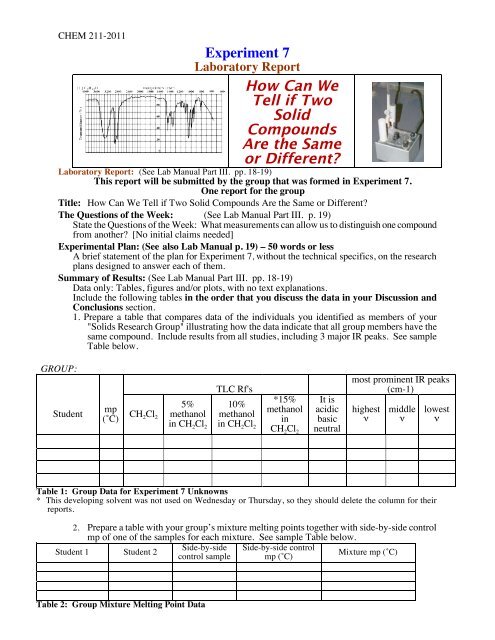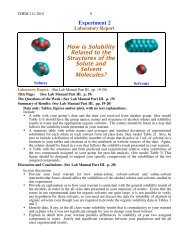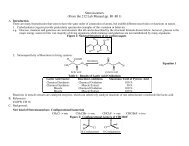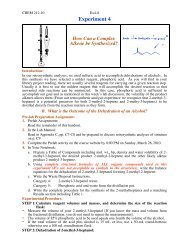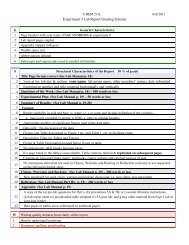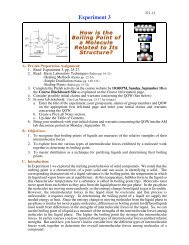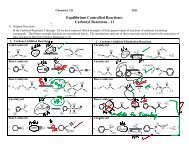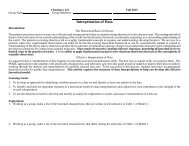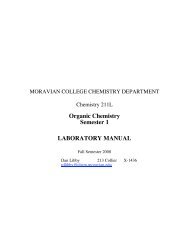Lab Report Format Sheet
Lab Report Format Sheet
Lab Report Format Sheet
You also want an ePaper? Increase the reach of your titles
YUMPU automatically turns print PDFs into web optimized ePapers that Google loves.
CHEM 211-2011<br />
Experiment 7<br />
<strong>Lab</strong>oratory <strong>Report</strong><br />
How Can We<br />
Tell if Two<br />
Solid<br />
Compounds<br />
Are the Same<br />
or Different<br />
<strong>Lab</strong>oratory <strong>Report</strong>: (See <strong>Lab</strong> Manual Part III. pp. 18-19)<br />
This report will be submitted by the group that was formed in Experiment 7.<br />
One report for the group<br />
Title: How Can We Tell if Two Solid Compounds Are the Same or Different<br />
The Questions of the Week: (See <strong>Lab</strong> Manual Part III. p. 19)<br />
State the Questions of the Week: What measurements can allow us to distinguish one compound<br />
from another [No initial claims needed]<br />
Experimental Plan: (See also <strong>Lab</strong> Manual p. 19) – 50 words or less<br />
A brief statement of the plan for Experiment 7, without the technical specifics, on the research<br />
plans designed to answer each of them.<br />
Summary of Results: (See <strong>Lab</strong> Manual Part III. pp. 18-19)<br />
Data only: Tables, figures and/or plots, with no text explanations.<br />
Include the following tables in the order that you discuss the data in your Discussion and<br />
Conclusions section.<br />
1. Prepare a table that compares data of the individuals you identified as members of your<br />
"Solids Research Group" illustrating how the data indicate that all group members have the<br />
same compound. Include results from all studies, including 3 major IR peaks. See sample<br />
Table below.<br />
GROUP:<br />
Student<br />
mp<br />
(˚C)<br />
CH 2 Cl 2<br />
5%<br />
methanol<br />
in CH 2 Cl 2<br />
TLC Rf's<br />
10%<br />
methanol<br />
in CH 2 Cl 2<br />
*15%<br />
methanol<br />
in<br />
CH 2 Cl 2<br />
It is<br />
acidic<br />
basic<br />
neutral<br />
most prominent IR peaks<br />
(cm-1)<br />
highest<br />
ν<br />
middle<br />
ν<br />
lowest<br />
ν<br />
Table 1: Group Data for Experiment 7 Unknowns<br />
* This developing solvent was not used on Wednesday or Thursday, so they should delete the column for their<br />
reports.<br />
2. Prepare a table with your group’s mixture melting points together with side-by-side control<br />
mp of one of the samples for each mixture. See sample Table below.<br />
Side-by-side Side-by-side control<br />
Student 1 Student 2<br />
Mixture mp (˚C)<br />
control sample mp (˚C)<br />
Table 2: Group Mixture Melting Point Data
<strong>Format</strong>ion of Solid Research Group 2 CHEM 211 Experiment 7<br />
3. Prepare a table that compares your team’s data with that of the other “Solids Research Groups” in your<br />
lab section. This table must include at least two key pieces of data from each of the other teams that<br />
allowed you to conclude that their compound is different from yours. You need not fill in the whole<br />
table, but include your data for each comparison. See sample Table below.<br />
GROUP:<br />
TLC Rf's<br />
It is<br />
most prominent IR peaks<br />
(cm-1)<br />
Group<br />
mp<br />
(˚C)<br />
CH 2 Cl 2<br />
5%<br />
methanol<br />
in CH 2 Cl 2<br />
10%<br />
methanol<br />
in CH 2 Cl 2<br />
15%<br />
methanol<br />
in CH 2 Cl 2<br />
acidic<br />
basic<br />
neutral<br />
highest<br />
ν<br />
middle<br />
ν<br />
lowest<br />
ν<br />
Your Group<br />
Table 3: Data Excluding Non-group Members for Experiment 7<br />
Claims, Warrants and Backing: (150 words or less)<br />
<strong>Format</strong>ion of Solids Research Group:<br />
Provide proof that you have successfully formed your "Solids Research Group". Specifically cite data<br />
from tables 1 & 2 that verifies that the samples of all members of your group are identical. Provide your<br />
warrant illustrating how you analyzed the data to formulate your claim. If some of the data are<br />
contradictory or equivocal, explain how they are outweighed by the preponderance of other data.<br />
Then cite data from Table 3 that allowed you to specifically exclude all others in your lab section.<br />
Provide your warrant illustrating how you analyzed the data to formulate your claim.<br />
Reflection: (100 words or less))<br />
This experiment allowed you to use techniques from earlier experiments and introduced infrared<br />
spectroscopy as a new characterization technique. Look back on the process your group members used to<br />
differentiate between those with the same compound and those with different compounds.<br />
Then look back at the techniques used and evaluate which ones were the most useful in distinguishing<br />
between different compounds and identifying identical compounds. If you now needed to determine<br />
whether two solid compounds might be identical, which technique would you use first Would it be the<br />
same if the compounds were liquids Provide a warrant for each claim.<br />
Appendix: (See <strong>Lab</strong> Manual Part III. p. 20)<br />
Include one set of handouts and all items in the Experiment 7 sections of each of your group members’<br />
Data Binders.<br />
<strong>Lab</strong>oratory <strong>Report</strong> Due Date:<br />
Your lab report for Experiment 7 is due in your lab period during the week of November 9-15.


